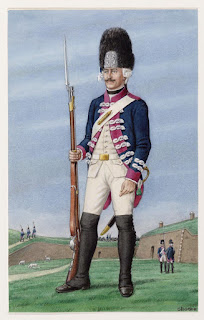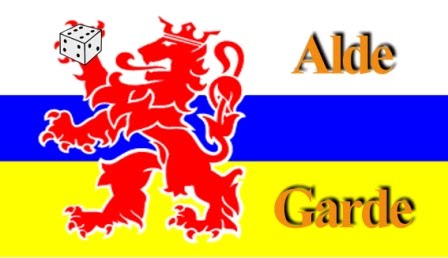INFANTRY
And while we are on the subject of the grenadiers, lets have a better look at the bearskins of the Dutch grenadiers in the FR period (1793-1795).
The grenadiers of the Dutch army in this period all wore the bearskin although grenadier officers also had the tricorne as they sometimes had to be on duty with musketeers; they then had according to the reglement to wear the tricorne.
Also one remarkable thing is, that the grenadiers had to wear their hairque underneath their bearskin unlike musketeers. Most pictures show this although there are exeptions.
In the mid 1750s both the Prussian style metallic plate fronted grenadiers mitre as the more southern style bearskin was worn by grenadiers but the mitre died out and only the bearskin cap remainded worn.
Up to the 1770s a lot of regiments had a bearskin with a smaller metal front plate as the Hollandse garde is wearing in the picture underneath (picture of the Rijksmuseum of around 1770 by Tethart Philp Christian Haag).
Some pictures of the front plated bearskin:

Dutch guard (Hollandse garde) 1768

 Wallon infant
Wallon infant
Swiss Guard; red facings but always shown with blue bag.


Hollandse garde with red facings and red bag

offficers of Hollandse garde
Grenadier drummer of the Hollandse garde
On the left Regiment Oranje Nassau I or II with red facings and red bag; on the right Garde Groningen again with red facings and red bag. The Garde Groningen was just one company strong and just ceremonial and not ment to go into the field.
Regiment Oranje Nassau III although later named Regiment Erfprins with orange facings and orange bag.
Again the regiment Erfprins (on the left) but on the right the regiment Walen (Walons-from 1790 regimental name Nassau-usingen) with white facings but blue grenadier bag.
Regiment infantry nr 24 Dundas in 1784 after changing their red coat into the normal blue coat. Facings are light blue but the bag is red.
In 1789 this became the regiment nr 24 Bentinck but the kept the same facing colour. Probably they kept their bag colour.
Regiment infantry nr 21 Westerloo (mariniers) with yellow facing and yellow bag
On the left a greandier and musketier of the Hollandse Garde (see above), the third figure is a grenadier of the regiment infantry nr 12 van Bylandt with red facings but blue grenadierbag (this regiment became in 1789 Bedaulx but kept its red facings and probably its bag colour)
On the right the 5th battalion Waldeck used as light infantry.
On the left again the Swiss guard (facings red, bag blue) and on the right the Swiss regiment of May with red facings and red bag.
This picture is of the Scots regiment nr 3 (Stuart) . When the uniform changed from red to blue in 1783 (and it received the regimental nr 23 but kept the name of Stuart) it kept its facing colour.
It is of course possible that it also kept its red grenadier bag.
Conclusion regarding the bag colour: mostly the bag was coloured the same as the facing colour but exceptions found were:
Swiss Guard: facing red, bag blue
reg inf nr 12 Bijlandt/Bedaulx: red facing, blue bag
reg inf nr 24 Bentinck: light blue facing, red bag
reg inf nr 23 Stuart: yellow facing, red bag
reg Wallon/Nassau Usingen: facing white, bag blue
CAVALRY
Regarding grenadiers it should be mentioned that the first (or Lijf) company of the guard dragoon regiment consisted of grenadiers which wore the bearskin.
Some pictures of the dragoon grenadiers are underneath but it should be mentioned that mostly a red bag is pictured but the last one show a blue bag. Probably a mistake or a change of colour?
pictures from the Dutch Army Museum (NMM)



 offficers of Hollandse garde
offficers of Hollandse garde



















No comments:
Post a Comment